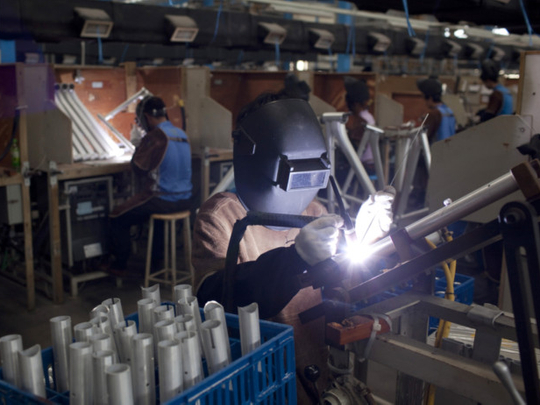
Beijing: China’s factories contracted in August the most in nine months, according to a survey showing falling export orders and rising inventories, signs that more policy action is probably needed to stop a slowdown in economic growth now in a seventh quarter.
The HSBC Flash China manufacturing purchasing managers index (PMI) fell to 47.8 in August, its lowest level since November, down from both the 49.5 July flash and the 49.3 final reading.
After hovering for several months just under the 50 mark that divides expansion from contraction, the index is now at levels rarely seen since the 2008-2009 global financial crisis.
“Inventory numbers are the highest on record. Orders to inventory are the lowest since December 2008. Foreign orders to inventory are the lowest since January 2009. It’s very hard to put a positive spin on anything within the data,” Robert Rennie, chief currency strategist at Westpac Bank, said.
“Bottom line — a very poor update with some very poor China data to come,” he said.
The risk of slower Chinese growth denting demand for Australian exports knocked a quarter of a US cent from the value of the Aussie dollar and depleted enthusiasm for regional equities, which gave up some of gains.
The survey provides an early peek at data for August, as well as an indication that a pick-up in economic growth may not have taken root as anticipated.
A fall in the new export orders sub-index to 44.7 — the lowest level since March 2009 — provides particularly bearish reading.
“To achieve the stated policy goal of stabilising growth and the jobs market, Beijing must step up policy easing to lift infrastructure investment in the coming months,” Qu Hongbin, chief China economist at HSBC in Hong Kong, said in a statement accompanying the index.
A sharp drop in China’s official producer price index in July, which marked the fifth straight month of producer price deflation, was also reflected in the HSBC survey. It showed a sub-index measuring factory input prices at its lowest level since March 2009.
The flash PMI also showed inventories piling up.
“Weaker-than-expected sales contributed to a further rise in holdings of finished goods at manufacturers’ plants,” Markit Economics, which conducted the survey, wrote in a note.
The HSBC PMI has been below 50 for 10 straight months, reinforcing calls from analysts and investors for further measures from Beijing to support economic growth.
China is loathe to unleash a massive stimulus package as it did in 2008. Instead, it has chosen to open more sectors to private capital to help fund new investment projects.
Zhang Zhiwei, chief China economist at Nomura in Hong Kong, was cautious about declaring that Beijing’s efforts to boost infrastructure investment and fast track fiscal spending plans had failed to gain traction.
“The effect of policy stimulus through infrastructure investment may not show up as strongly in the HSBC PMI as in the official PMI as the former focuses more on private companies,” Zhang wrote in a note to clients, adding that China’s official PMI — due on September 1 — will be the best guide to whether economic momentum is slowing and requiring a bigger response.
The flash PMI is based on 85-90 per cent of total PMI survey responses, set to be published in full on September 3.
Employment
HSBC’s flash employment sub-index was unchanged from June, when it had registered its lowest level since March 2009, the point at which China began to pull out of the trough of the global financial crisis.
Falling demand from debt-ridden Europe — China’s single biggest export market — has put the Chinese economy under pressure.
Data from elsewhere in Asia shows the risk that Europe’s problems could be spilling out regionally courtesy of China’s exposure to a downturn in its biggest foreign market.
Japan said on Wednesday that exports slumped the most in six months in July as shipments to Europe and China tumbled. Exports from Taiwan, a key part of the global technology supply chain, fell for a fifth straight month in July. South Korea, home to major carmakers, computer chip and flat-screen producers, recorded its sharpest export fall in July in nearly three years.
Chinese government data last month showed July exports rose just 1 per cent from a year earlier and that new loans were at a 10-month low. Factory output rose at its lowest pace in three years and pricing power faded.
That raised the spectre of a seventh straight quarter of slowing growth in July-September, after the second-quarter expanded 7.6 per cent from a year earlier, only just above Beijing’s official 7.5 per cent target.
The prospect of unemployed workers taking to the streets is a top worry for China’s ruling Communist Party, particularly ahead of a once-in-a-decade leadership transition this autumn.
However, unemployment levels have not yet come close to those of the winter of 2008-2009. At least 20 million jobs were lost in export-oriented coastal provinces when global trade ground to a halt then. Some estimates put the total as high as 40 million.
Analysts broadly believe a headline PMI of 48 is consistent with manufacturing output strong enough to deliver the jobs growth that China’s government needs to absorb millions of new graduates and rural migrant workers each year.
China has been “fine tuning” policies to keep growth on track without releasing curbs on the property sector. Some cash-strapped municipalities that have tried to loosen curbs unilaterally have been forced to retreat.
Instead, Beijing has fast-tracked fiscal spending on key projects, cut the amount of cash banks must keep as reserves to free an estimated 1.2 trillion yuan for lending ($190 billion, Dh697.8 billion) and, in the space of four weeks in June and July, twice lowered benchmark lending rates.
Analysts polled by Reuters expect one more cut to interest rates of 25 basis points and 100 bps of cuts in banks’ required reserve ratios by the end of the year.











